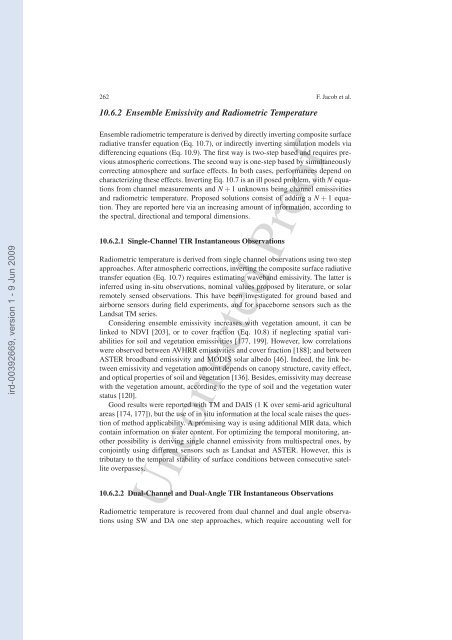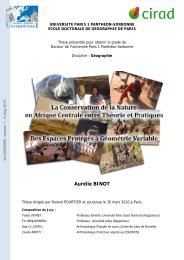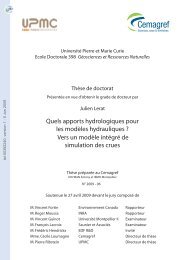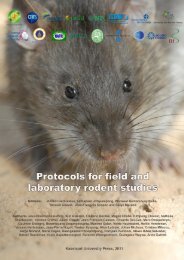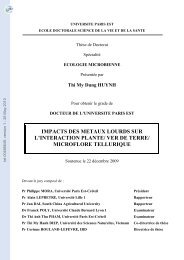Modeling and Inversion in Thermal Infrared Remote Sensing over ...
Modeling and Inversion in Thermal Infrared Remote Sensing over ...
Modeling and Inversion in Thermal Infrared Remote Sensing over ...
Create successful ePaper yourself
Turn your PDF publications into a flip-book with our unique Google optimized e-Paper software.
262 F. Jacob et al.10.6.2 Ensemble Emissivity <strong>and</strong> Radiometric Temperatureird-00392669, version 1 - 9 Jun 2009Ensemble radiometric temperature is derived by directly <strong>in</strong>vert<strong>in</strong>g composite surfaceradiative transfer equation (Eq. 10.7), or <strong>in</strong>directly <strong>in</strong>vert<strong>in</strong>g simulation models viadifferenc<strong>in</strong>g equations (Eq. 10.9). The first way is two-step based <strong>and</strong> requires previousatmospheric corrections. The second way is one-step based by simultaneouslycorrect<strong>in</strong>g atmosphere <strong>and</strong> surface effects. In both cases, performances depend oncharacteriz<strong>in</strong>g these effects. Invert<strong>in</strong>g Eq. 10.7 is an ill posed problem, with N equationsfrom channel measurements <strong>and</strong> N + 1 unknowns be<strong>in</strong>g channel emissivities<strong>and</strong> radiometric temperature. Proposed solutions consist of add<strong>in</strong>g a N + 1 equation.They are reported here via an <strong>in</strong>creas<strong>in</strong>g amount of <strong>in</strong>formation, accord<strong>in</strong>g tothe spectral, directional <strong>and</strong> temporal dimensions.10.6.2.1 S<strong>in</strong>gle-Channel TIR Instantaneous ObservationsRadiometric temperature is derived from s<strong>in</strong>gle channel observations us<strong>in</strong>g two stepapproaches. After atmospheric corrections, <strong>in</strong>vert<strong>in</strong>g the composite surface radiativetransfer equation (Eq. 10.7) requires estimat<strong>in</strong>g waveb<strong>and</strong> emissivity. The latter is<strong>in</strong>ferred us<strong>in</strong>g <strong>in</strong>-situ observations, nom<strong>in</strong>al values proposed by literature, or solarremotely sensed observations. This have been <strong>in</strong>vestigated for ground based <strong>and</strong>airborne sensors dur<strong>in</strong>g field experiments, <strong>and</strong> for spaceborne sensors such as theL<strong>and</strong>sat TM series.Consider<strong>in</strong>g ensemble emissivity <strong>in</strong>creases with vegetation amount, it can bel<strong>in</strong>ked to NDVI [203], or to c<strong>over</strong> fraction (Eq. 10.8) if neglect<strong>in</strong>g spatial variabilitiesfor soil <strong>and</strong> vegetation emissivities [177, 199]. However, low correlationswere observed between AVHRR emissivities <strong>and</strong> c<strong>over</strong> fraction [188]; <strong>and</strong> betweenASTER broadb<strong>and</strong> emissivity <strong>and</strong> MODIS solar albedo [46]. Indeed, the l<strong>in</strong>k betweenemissivity <strong>and</strong> vegetation amount depends on canopy structure, cavity effect,<strong>and</strong> optical properties of soil <strong>and</strong> vegetation [136]. Besides, emissivity may decreasewith the vegetation amount, accord<strong>in</strong>g to the type of soil <strong>and</strong> the vegetation waterstatus [120].Good results were reported with TM <strong>and</strong> DAIS (1 K <strong>over</strong> semi-arid agriculturalareas [174, 177]), but the use of <strong>in</strong> situ <strong>in</strong>formation at the local scale raises the questionof method applicability. A promis<strong>in</strong>g way is us<strong>in</strong>g additional MIR data, whichconta<strong>in</strong> <strong>in</strong>formation on water content. For optimiz<strong>in</strong>g the temporal monitor<strong>in</strong>g, anotherpossibility is deriv<strong>in</strong>g s<strong>in</strong>gle channel emissivity from multispectral ones, byconjo<strong>in</strong>tly us<strong>in</strong>g different sensors such as L<strong>and</strong>sat <strong>and</strong> ASTER. However, this istributary to the temporal stability of surface conditions between consecutive satellite<strong>over</strong>passes.10.6.2.2 Dual-Channel <strong>and</strong> Dual-Angle TIR Instantaneous ObservationsUncorrected ProofRadiometric temperature is rec<strong>over</strong>ed from dual channel <strong>and</strong> dual angle observationsus<strong>in</strong>g SW <strong>and</strong> DA one step approaches, which require account<strong>in</strong>g well for


